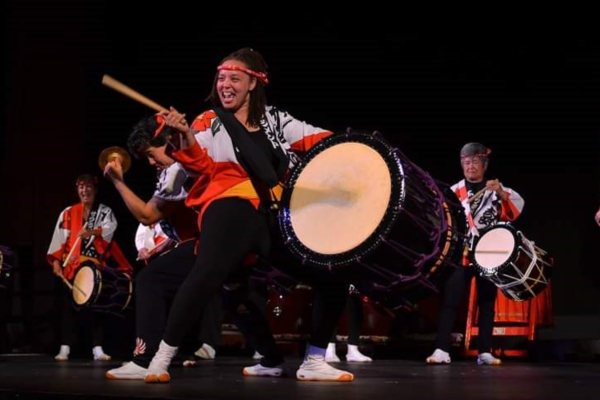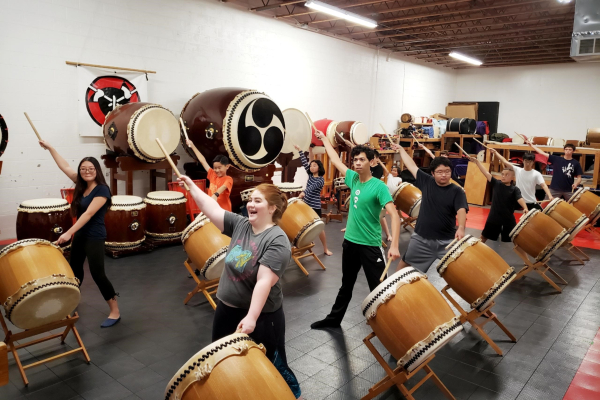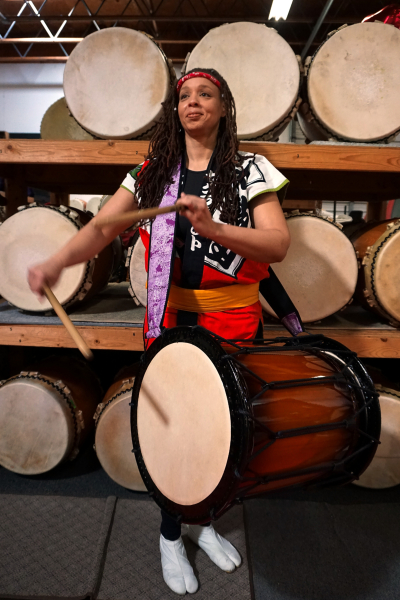Just a minute away from car horns and chaos of Arden Fair Mall is the home of Sacramento Taiko Dan, the oldest local organization dedicated to the art of Japanese percussion. Inside a blue, inconspicuous warehouse you’ll find racks of drums of all sizes and wear stacked on high. In the middle of the space stands the showstopper, the highly-decorated odaiko, or “big fat drum,” made by famed Asano Taiko. Though silent now, in just a few hours, the dojo will be filled with thunderous rhythms.
Greeting us for this month’s installment of Sacramento365’s Featured Artist Series is Sacramento Taiko Dan’s Sascha Molina, dressed in a traditional happi, a decorative, thin-fabric coat, and hachimaki, a traditional headband.
A member of the organization for the last 12 years, she swiftly climbed the ranks, moving from student to now the Assistant Artistic Director and the Director of the Sacramento Taiko Dan Youth Ensemble. As an instructor, she focuses on giving others opportunities to grow and learn life skills through music and cultural literacy — just as Sacramento Taiko Dan has done for her.
Read on to learn more on how Molina found her rhythm — and purpose — in Sacramento Taiko Dan.
Taiko, literally meaning “drum,” is an ancient form of percussion, used as the soundtrack of warfare and religious ceremonies for centuries in Japan. Despite regional differences, all taiko practice is defined by its structured choreography, drumbeats, and shouts.
In America, the artform blossomed post-World War II. Practicing taiko was an act of resilience for Japanese-Americans, a means of stitching together communities and reclaiming cultural traditions after withstanding the traumas of Internment. (In 1968, Seiichi Tanaka formed the first US taiko group, the San Francisco Taiko Dojo.) [1]
In 1989, Executive Director Tiffany Tamaribuchi founded Sacramento Taiko Dan out of necessity: at the time, there was no organization dedicated to the cultural art in the region. Since inception, the nonprofit has been on a mission to promote cultural awareness through quality performances and instruction throughout Sacramento.

So how did Molina, a SoCal transplant, get involved with Sacramento Taiko Dan? A lifelong fascination with Japanese culture explains part of it.
“I love learning about different cultures, but Japanese culture has been the one that I’ve been drawn to the most. One of my best friends from high school who was Japanese, [gave me a taste] of the culture firsthand. Her house was awesome, and her mom would always make us great Japanese food after volleyball practice. I’d always ask her ‘Why aren’t you more into your culture? It’s so cool’ but she wanted nothing to do with it. Being African American, I don’t know my origins and I always thought it would be so incredible to pinpoint exactly where you came from. I’ve always craved such a thing.”
After years of searching for Taiko courses down south, she found Sacramento Taiko Dan online after moving to Sacramento 12 years ago. She was finally able to connect with the rhythms and movements she fell in love with on YouTube. Being one of the last students standing from her introductory class helped get her noticed; she quickly moved up to the intermediate player group and eventually became a part of Sacramento Taiko Dan’s leadership.
“Howard [a previous performing member of the group who has since passed] saw my skills, pulled me aside, and told me straight: you are going to need to learn more on your own. [At that time, classes were structured differently.] He sent me these DVDs and VHSes and I would practice them on my own time. When our founder Tiffany came by and asked me to play something, I could; whereas others in the group could only play a single part,” recalls Molina. “I soon got to play more and began coaching others around me.”
Five years ago, she then made the transition to Assistant Artistic Director, focusing on program outreach and youth education (she’s also currently the Director of the Sacramento Taiko Dan Youth Ensemble). And her schedule is hectic, to say the least.
Weekly Breakdown of Sacramento Taiko Dan Responsibilities (when not traveling):
Mondays 7pm-9pm: Beginning Adult Session (~12 people)
Wednesdays 7pm-9pm: Performer Practice (12) (but does not teach regularly)
Thursdays 7pm-9pm: Adult Performing and Intermediate Session (16)
Fridays 6pm-7:30pm: Beginning Youth Session (10)
Fridays 7:30pm-8:30pm: Performing Youth Ensemble Practice (8)
Throughout the week: Special events, school assemblies/school performances, Artist in Residence commitments, etc.
And, oh yeah, she does all this work for free. To help make ends meet, Molina teaches taiko independently at University Charter Prep in El Dorado as part of its Asian Studies Program.
While grueling, teaching for Molina, is important. Not only does she wish to educate others on the historical significance of taiko, she also hopes that her presence will squash the misconception that cultural arts are exclusionary.
“It is important for me to be seen — especially by the kids — because people see cultural arts and immediately think ‘I’m not from that culture, so I can’t do that.’ When I [perform at] schools, it’s interesting to see how the kids react to me. ‘Wow. You do this?’”
And learning goes both ways. Inquisitive audiences and students have made Molina a better performer and person: “I have learned patience and joy watching people respond to taiko. Taiko is really transformative in the way that it can be an outlet for many emotions. If you are having a joyous day, you can [convey that] through a drum. If you have an upsetting day, you can let it out on a drum.”
“I love how taiko connects me to so many people and lets me watch people grow,” she continues.
While Molina finds the Sacramento arts community thriving and supportive – “as a community that has really done a lot without a lot of funding” — her perception of the state of our arts education is less than stellar.
“It’s horrible. There are so many schools without arts education at all. It’s sad [when] arts are seen as not needed. I’ve personally seen how arts education has changed a person. There are so many life skills being lost not having arts in schools. It would be nice for every child to have that opportunity to be exposed to the arts.”
Molina cites that taiko, like sports, teaches the fundamentals of humility and team-building: students learn coordination, collaboration, and coping mechanisms — just with a bellowing beat.
Thankfully, Molina and Sacramento Taiko Dan are increasing student arts exposure by participating in the Any Given Child Program (AGC). Developed in partnership with The Kennedy Center for the Performing Arts, and administered locally by the Sacramento Metropolitan Arts Commission, AGC provides access and equity to arts education during the school day for K-8 students in the Elk Grove Unified, Robla, Sacramento City Unified, and Twin Rivers School Districts. It does so with teaching artist residencies, arts exposure experiences (e.g. school assemblies), and professional development.

Sacramento Taiko Dan is currently involved in AGC’s artist residencies and arts exposure initiatives. During school assemblies, adult performers speak on Japanese culture, perform, and even let students try their hand on a drum. These performances, however, last just 45 minutes.
Luckily, Molina spends more time with students as an artist in residence: “that’s where you really get to see what’s going on. You are there a little bit longer. I feel this is where I get to make a larger impact on students.”
[Note: Sacramento Taiko Dan also operates its own Taiko in Schools arts education program.]
Outside school hours, Sacramento Taiko Dan performs throughout the community and offers youth and adult taiko instruction — equity and access always top of mind.
“It’s hard nowadays. Parents want their kids to try many, many things. We support the community [at large] by doing a lot of things for free…and when we hold workshops and performances, we do our best to keep prices down. If you or your child are interested in learning taiko but the price seems out of reach, please email or call. We might be able to work something out.”
This year marks Sacramento Taiko Dan’s 30th year. To celebrate, the group is putting its energy into two events, honoring both its past and its vision of the future. On May 2, the nonprofit is hosting international taiko group, Shidara, at the Community Center Theater. The group expects to highlight its resiliency with a knock-out concert this September — its venue and program to be determined.
No matter how their festivities pan out, Sacramento Taiko Dan’s pearl anniversary is a testament to the patience and resolve of its community of artists: “we are a very loving place to come to and be a part of. We come together, from all walks of life, for the same goal: to play taiko. We’re a family, and we’ve got room for more.”

Interested in Taiko? Here’s are a few fundamental terms you should know:
Bachi: Drum sticks
Hachimaki: Traditional headband
Happi: Decorative, short kimono-like coat
Kakegoe: Shouts used to accent music and encourage other performers
Kata: The way of doing something (e.g. stances or movements)
Ki: Body’s energy or spirit
Ma: The space between drum strikes
Odori: Japanese dance
Tabi: Split-toed socks often worn during performances
*Terms were slightly modified from Taiko.com.
Molina squashes a few misconceptions on the performing art.
Do you need a background in music or percussion in order to play taiko?
Though helpful, it’s definitely not a pre-requisite. If you like to dance, listen to music and feel the groove, you can play!
You must be young to perform?
Thankfully, taiko is for all ages.
You have to be Japanese to participate.
Wrong, this cultural artform is open to anyone who wants to try.
Do you need to speak Japanese?
Nope! Most Taiko players in North America do not speak Japanese, but if you want to pursue a professional career in taiko, I would recommend learning Japanese.

We couldn’t let these interview tidbits hit the cutting room floor:
Facebook*
*The best source for Sacramento Taiko Dan updates.
Website
Have questions about Sacramento Taiko Dan?
Email Sascha Molina at sascha124@hotmail.com.
Footnotes:
[1] http://www.sftaiko.com/gmtanaka-2017